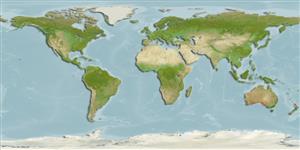>
Siluriformes (Catfishes) >
Plotosidae (Eeltail catfishes)
Etymology: Cnidoglanis: Greek, knide = nettle + Greek, glanis = a fish that can eat the bait without touching the hook; a cat fish (Ref. 45335).
More on author: Valenciennes.
Environment: milieu / climate zone / depth range / distribution range
Ecologie
marien; brak water demersaal; diepte 1 - 30 m (Ref. 6390). Temperate; 28°S - 37°S
Indo-Pacific: endemic to Australia. Present along both eastern and western Australian coasts, from Kirra in southern Queensland to Jervis Bay in New South Wales, and from Kingston in South Australia to the Houtman Abrolhos in Western Australia. Distributional range extension to the Duck River in Tasmania (Ref. 7300) needs verification.
Lengte bij maturiteit / Grootte / Gewicht / Leeftijd
Maturity: Lm ?, range 41 - ? cm
Max length : 91.0 cm SL mannelijk / geslacht onbekend; (Ref. 33840); max. gepubliceerd gewicht: 2.5 kg (Ref. 6390); max. gerapporteerde leeftijd: 13 Jaren (Ref. 6390)
Korte beschrijving
Morfologie | Morfometrie
Dorsale stekels (totaal): 1; Dorsale zachte stralen (totaal): 105-134; Anale stekels 0; Anale zachte stralen: 95 - 112; Wervels: 77 - 78
An inshore marine species which lives in shallow bays and sandy inlets near river mouths (Ref. 2156). Found most frequently over sand, rocks and weeds in clear to turbid waters. By day, cobblers are most often found in holes and on ledges in banks (Ref. 6390). They are opportunistic feeders, primarily feeding at night. Food consists of bivalve and univalve mollusks, crustaceans (small prawns and amphipods), polychaete worms, algae and organic debris (Ref. 26551). Juveniles eat more crustaceans, often from among drifting macrophytic algae (Ref. 26548). Adults feed mainly on mollusks and polychaetes (Ref. 6390). They are prey to birds such as cormorants and pelicans (Ref. 26548). Presence of sharp spines on the dorsal and pectoral fins can inflict painful wounds (Ref. 2156).
Males guard the eggs between their pelvic fins for an unknown period in the nest which the male have constructed. The drift weeds found in inshore marine waters, protected inshore marine environments and estuaries act as nursery areas. Cobbler enter these areas during their first year of life and often remain there for long periods (Refs. 26548, 26549).
Paxton, J.R., D.F. Hoese, G.R. Allen and J.E. Hanley, 1989. Pisces. Petromyzontidae to Carangidae. Zoological Catalogue of Australia, Vol. 7. Australian Government Publishing Service, Canberra, 665 p. (Ref. 7300)
Status op de Rode Lijst van het IUCN (Ref. 130435)
Gebruik door de mens
Visserij: van minder commercieel belang; sportvis: ja
Meer informatie
ReferentiesAquacultuurAquacultuurprofielKweeklijnenGeneticaElectrophoresesErfelijkheidZiektesVerwerkingNutrientsMassaconversie
Tools
Speciale rapporten
Download XML
Internetbronnen
Estimates based on models
Preferred temperature (Ref.
123201): 16.8 - 22.3, mean 18.2 °C (based on 192 cells).
Fylogenetische diversiteitsindex (Ref.
82804): PD
50 = 1.0000 [Uniqueness, from 0.5 = low to 2.0 = high].
Bayesian length-weight: a=0.00457 (0.00199 - 0.01049), b=3.07 (2.86 - 3.28), in cm total length, based on LWR estimates for this (Sub)family-body shape (Ref.
93245).
Trofisch niveau (Ref.
69278): 2.8 ±0.32 se; based on food items.
Generation time: 5.5 ( na - na) years. Estimated as median ln(3)/K based on 2
growth studies.
Weerstandsvermogen (Ref.
120179): Gemiddeld, minimale populatieverdubbelingstijd 1,4-4,4 jaar (tm=2-3; tmax=13; Fec=300).
Fishing Vulnerability (Ref.
59153): Moderate to high vulnerability (54 of 100).
Nutrients (Ref.
124155): Calcium = 35.7 [16.7, 57.7] mg/100g; Iron = 0.342 [0.202, 0.584] mg/100g; Protein = 16.6 [14.7, 18.7] %; Omega3 = 0.351 [0.187, 0.639] g/100g; Selenium = 14.9 [7.3, 31.5] μg/100g; VitaminA = 7.42 [2.66, 21.37] μg/100g; Zinc = 0.641 [0.445, 0.923] mg/100g (wet weight);
